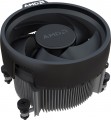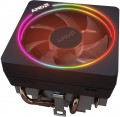Max. TDP
The maximum TDP provided by the cooling system. Note that this parameter is indicated only for solutions equipped with heatsinks (see "Type"); for separately made fans, the efficiency is determined by other parameters, primarily by the air flow values (see above).
TDP can be described as the amount of heat that a cooling system is able to remove from a serviced component. Accordingly, for the normal operation of the entire system, it is necessary that the TDP of the cooling system is not lower than the heat dissipation of this component (heat dissipation data is usually indicated in the detailed characteristics of the components). And it is best to select coolers with a power margin of at least 20 – 25% — this will give an additional guarantee in case of forced operation modes and emergency situations (including clogging of the case and reduced air exchange efficiency).
As for specific numbers, the most modest modern cooling systems provide TDP
up to 100 W, the most advanced —
up to 250 W and even
higher.
Min. RPM
The lowest speed at which the cooling fan is capable of operating. Specified only for models with speed control (see below).
The lower the minimum speed (with the same maximum) — the wider the speed control range and the more you can slow down the fan when high performance is not needed (such a slowdown allows you to reduce energy consumption and noise level). On the other hand, an extensive range affects the cost accordingly.
Max. RPM
The highest speed at which the cooling system fan is capable of operating; for models without a speed controller (see below), this item indicates the nominal rotation speed. In the "slowest" modern fans, the maximum speed
does not exceed 1000 rpm, in the "fastest" it can be up
to 2500 rpm and even
more.
Note that this parameter is closely related to the fan diameter (see above): the smaller the diameter, the higher the speed must be to achieve the desired airflow values. In this case, the rotation speed directly affects the level of noise and vibration. Therefore, it is believed that the required volume of air is best provided by large and relatively "slow" fans; and it makes sense to use "fast" small models where compactness is crucial. If we compare the speed of models of the same size, then higher speeds have a positive effect on performance, but increase not only the noise level, but also the price and power consumption.
Heat pipes
Number of heat pipes in the cooling system
The heat pipe is a hermetically sealed structure containing a low-boiling liquid. When one end of the tube is heated, this liquid evaporates and condenses at the other end, thus removing heat from the heating source and transferring it to the cooler. Nowadays, such devices are widely used mainly in processor cooling systems (see "Intended use") — they connect the substrate that is in direct contact with the CPU and the heatsink of the active cooler. Manufacturers select the number of tubes based on the overall performance of the cooler (see "Maximum TDP"); however, models with similar TDPs can still differ markedly in this parameter. In such cases, it is worth considering the following: increasing the number of heat pipes increases the efficiency of heat transfer, but also increases the dimensions, weight and cost of the entire structure.
As for the number, the simplest models provide
1 – 2 heat pipes, and in the most advanced and powerful processor systems, this number can be
7 or more.
Heatpipe contact
The type of contact between the heat pipes provided in the heatsink of the cooling system and the cooled components (usually the CPU). For more information about heat pipes, see above, and the types of contact can be as follows:
—
Indirect. The classic version of the design: heat pipes pass through a metal (usually aluminium) base, which is directly adjacent to the surface of the chip. The advantage of such contact is the most even distribution of heat between the tubes, regardless of the physical size of the chip itself (the main thing is that it should not be larger than the sole). At the same time, the extra piece between the processor and the tubes inevitably increases thermal resistance and slightly reduces the overall cooling efficiency. In many systems, especially high-end ones, this drawback is compensated by various design solutions (primarily by the tightest connection of the tubes with the sole), but this, in turn, affects the cost.
—
Direct. With direct contact, the heat pipes fit directly on the cooled chip, without an additional sole; for this, the surface of the tubes on the desired side is ground down to a plane. Due to the absence of intermediate parts, the thermal resistance at the places where the tubes fit is minimal, and at the same time, the radiator design itself is simpler and cheaper than with indirect contact. On the other hand, there are gaps between the heat
...pipes, sometimes very large — as a result, the surface of the serviced chip is cooled unevenly. This is partly offset by the presence of a substrate (in this case, it fills these gaps) and the use of thermal paste, however, in terms of uniformity of heat removal, direct contact is still inevitably inferior to indirect contact. Therefore, this option is found mainly in inexpensive coolers, although it can also be used in fairly performant solutions.Heatsink material
—
Copper. Copper has a high thermal conductivity and provides efficient heat dissipation, but such radiators are quite expensive.
—
Aluminium. Aluminium is cheaper than copper, but its thermal conductivity, and, accordingly, its efficiency is somewhat lower.
—
Aluminium/copper. Combined design — usually, a radiator is made of aluminium, and heat pipes are made of copper. This combination achieves good performance without a significant increase in cost. This type of heatsink applies only to active coolers.
Plate material
The material from which the substrate of the cooling system is made is the surface that is in direct contact with the cooled component (most often the processor). This parameter is especially important for models with heat pipes (see above), although it can be specified for coolers without this function. Options can be as follows:
aluminium,
nickel-plated aluminium,
copper,
nickel-plated stranded. More about them.
— Aluminium. The traditional, most common backing material. At a relatively low cost, aluminium has good thermal conductivity characteristics, is easy to grind (required for a snug fit), and well resists scratches and other irregularities, as well as corrosion. However in terms of heat removal efficiency, this material is still inferior to copper — however, this becomes noticeable mainly in advanced systems that require the highest possible thermal conductivity.
— Copper. Copper is noticeably more expensive than aluminium, but this is offset by higher thermal conductivity and, accordingly, cooling efficiency. The noticeable disadvantages of this metal include some tendency to corrosion when exposed to moisture and certain substances. Therefore, pure copper is used relatively rarely — nickel-plated substrates are more common (see below).
— Nickel-plated copper. Copper substrate with an additional n
...ickel coating. Such a coating increases resistance to corrosion and scratches, while it practically does not affect the thermal conductivity of the substrate and work efficiency. However this feature somewhat increases the price of the radiator, but it is found mainly in high-end cooling systems, where this moment is almost invisible against the background of the overall cost of the device.
— Nickel-plated aluminium. Aluminium substrate with an additional nickel coating. For aluminium in general, see above, and the coating makes the heatsink more resistant to corrosion, scratches, and burrs. On the other hand, it affects the cost, despite the fact that in fact, pure aluminium is often quite sufficient for efficient operation (especially since this metal itself is very resistant to corrosion). Therefore, this variant was not distributed.Lighting
The presence
of its own illumination in the design of the cooling system.
The backlight serves a purely aesthetic function — it gives the device a stylish appearance that blends well with other components in the original design. Thanks to this, such cooling systems are especially appreciated by gamers and fans of external PC modding — especially since the lighting can be different, and the most advanced models even provide backlight synchronization with other components (see below). On the other hand, this function does not affect the efficiency and performance, and the overall cost is inevitably affected, sometimes quite noticeably. Therefore, if the appearance does not play a fundamental role for you, the best choice, most likely, will be
a cooling system without backlight.
Lighting colour
The colour of the backlight installed in the cooling system.
See above for more details on the backlight itself. Also note here that in the illumination of modern cooling systems there is both one colour (most often
red or
blue, less often
green,
yellow,
white or
purple), and multi-colour systems such as
RGB and
ARGB. The choice of a single-colour backlight depends mainly on aesthetic preferences, but the last two varieties should be touched upon separately.
The basic principle of operation of both RGB and ARGB systems is the same: the design provides for a set of LEDs of three basic colours — red (Red), green (Green) and blue (Blue), and by changing the number and brightness of the included LEDs, you can not only intensity, but and tint of light. The difference between these options differs in functionality: RGB systems support a limited set of colours (usually up to one and a half dozen, or even less), while ARGB allows you to choose almost any shade from the entire available colour range. At the same time, both of them can support backlight synchronization (see below); in general, this function is not required for RGB and ARGB systems, but it is used almost exclusively in them.

